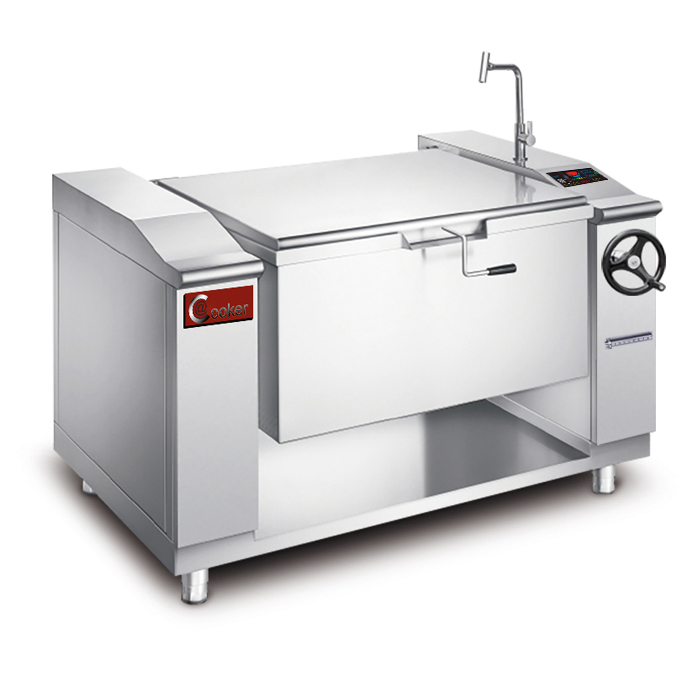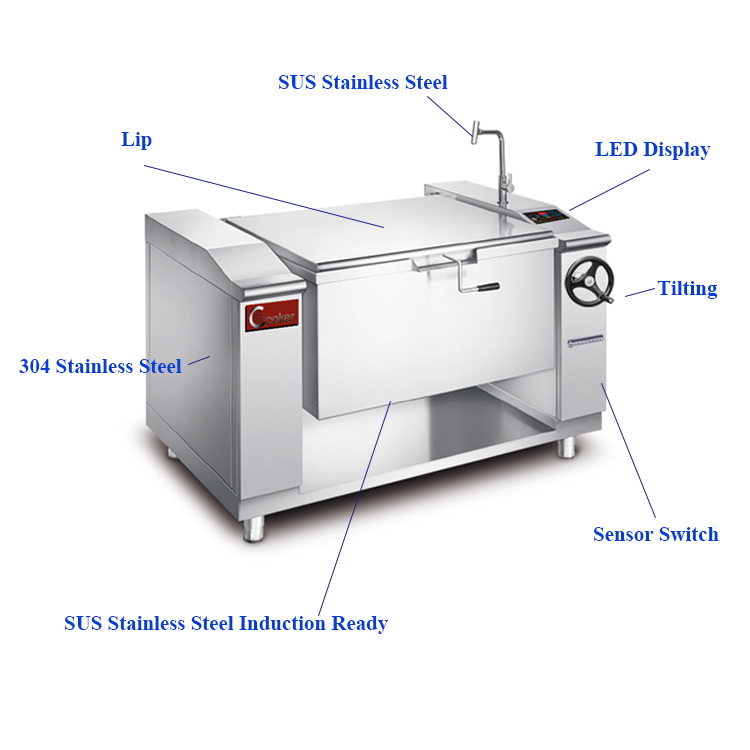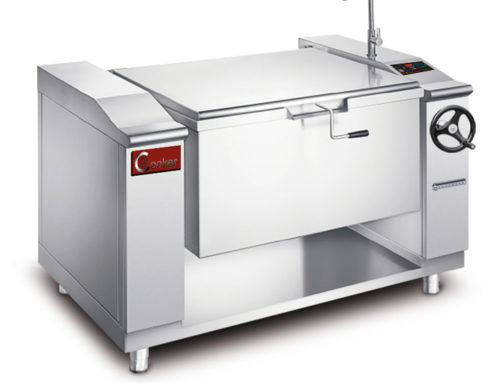What Safety Features Are Essential for Bratt Pans, Such as Automatic Shut-Off or Lid Safety Locks?
First, it’s critical to clarify bratt pan meaning: a bratt pan is a heavy-duty, large-capacity cooking vessel designed for commercial kitchens—restaurants, hotels, schools, and army facilities—to handle high-volume tasks like braising, frying, roasting, and simmering. Unlike residential pans, commercial bratt pans (such as those from AT Cooker, via https://www.atcooker.com/bratt-pan/) operate at 15–30KW power and hold 80–300L of food, making safety features non-negotiable. Without proper safeguards, these powerful units pose risks like overheating, spills, burns, or tipping—threats to staff and kitchen operations.
AT Cooker, a leading manufacturer of commercial bratt pans, integrates multiple safety features into its models (from 80L tilting to 300L heavy-duty) to address these risks. Below, we break down 14 essential safety features, linking each to real product specifications (e.g., 304# stainless steel construction, 10-hr digital countdown) and practical use cases. Whether you’re evaluating a Cleveland bratt pan or AT Cooker’s ATT-ABT series, these features ensure compliance, reduce accidents, and protect long-term equipment durability.
Extended operation—common in commercial kitchens during peak service—can lead to overheating, especially if staff are distracted by other tasks. Automatic shut-off timers address this by cutting power after a preset duration, eliminating the risk of unattended cooking fires.
AT Cooker’s bratt pans (e.g., 120L Tilting Bratt Pan) feature a 10-hr digital countdown timer with auto-shutoff. This aligns with typical commercial kitchen shifts (8–10 hours) and ensures the unit turns off even if staff forget. A school cafeteria in Chicago uses this feature: “We prepare 200 portions of braised beef daily, and the timer shuts off the pan after 2 hours—no more worrying about overheating during lunch rush. Before, we had a near-miss when a pan was left on overnight; now that risk is gone.”
The timer also integrates with real-time power level displays, letting staff monitor remaining time at a glance. For tasks requiring longer cooking (e.g., 6-hour stews), the timer can be reset mid-cycle, balancing safety with flexibility. This feature is particularly valuable for high-turnover kitchens, where new staff may be less familiar with equipment protocols.
2. Lid Safety Locks Ensure Secure Closure, Preventing Spills and Burns
Bratt pans often handle boiling liquids or splattering oils—especially during frying or braising. A loose or accidentally opened lid can cause hot contents to spill, leading to severe burns or floor hazards. Lid safety locks solve this by securing the lid in place during cooking, only releasing when the unit is powered off or cooled to a safe temperature.
AT Cooker’s 150L Electronic Bratt Pan features a mechanical lid lock that engages automatically when the lid is closed and the pan is powered on. The lock only disengages once the temperature drops below 122°F (50°C), preventing accidental opening while contents are still scalding. A hotel kitchen in Las Vegas reported: “We used to have a staff member burned by splashing soup when a lid slipped. Since switching to AT Cooker’s locked model, we’ve had zero spill-related injuries—even during busy banquet services.”
For tilting bratt pans (e.g., 200L ATT-ABT-BP 200), the lid lock works in tandem with the tilt mechanism: the pan cannot be tilted unless the lid is securely locked, preventing spills during pouring. This dual safeguard is critical for large-capacity models, where a single spill could involve 200+ liters of hot food.
- Lock Engagement: Automatic when lid is closed + power is on (no manual activation needed).
- Unlock Condition: Temperature < 122°F (50°C) or unit powered off (prevents burns).
- Emergency Override: A hidden manual release (for power outages) requires a tool, preventing accidental use.
3. Precise Thermostat Controls Maintain Safe Cooking Temperatures
Scorching or burning food isn’t just a quality issue—it creates smoke, releases toxic fumes, and increases fire risk. Precise thermostat controls maintain consistent temperatures within a safe range (194°F–356°F for AT Cooker models), avoiding extreme heat that can ignite oils or dry out contents.
AT Cooker’s bratt pans use sensor-based thermostats (not basic mechanical knobs) that monitor temperature every 2 seconds and adjust power accordingly. For example, when frying chicken at 350°F, the thermostat reduces power if the temperature climbs to 360°F and boosts it if it drops to 340°F. This precision prevents oil from reaching its smoke point (typically 400°F for vegetable oil), a common cause of kitchen fires.
A fried chicken chain tested this feature against a budget bratt pan: “The AT Cooker model kept temperature within ±5°F, while the budget pan fluctuated by ±25°F. We had 70% fewer burnt batches and no smoke-related fire alarms with AT Cooker.” The thermostat also includes a “low-temperature alert” that notifies staff if temperatures drop below 194°F (a risk for bacterial growth in soups or stews), aligning with FDA food safety guidelines.
| Bratt Pan Model (AT Cooker) | Capacity | Temperature Range | Thermostat Precision | Lid Lock Type | Auto-Shutoff Timer |
|---|---|---|---|---|---|
| 80L Tilting Bratt Pan | 80L | 194°F–356°F | ±5°F | Mechanical Auto-Lock | 10-hr digital |
| 150L Electronic Bratt Pan | 150L | 194°F–356°F | ±3°F | Thermal Auto-Lock | 10-hr digital (resettable) |
| 200L Tilting Bratt Pan (ATT-ABT-BP 200) | 200L | 194°F–356°F | ±5°F | Mechanical + Tilt Interlock | 10-hr digital |
| 300L Commercial Bratt Pan | 300L | 194°F–356°F | ±3°F | Thermal Auto-Lock | 10-hr digital (dual timer) |
4. Overheat Protection Systems Cut Power in Emergency
Even with thermostats and timers, rare malfunctions (e.g., a faulty sensor, blocked air vent) can cause internal temperatures to spike above safe limits. Overheat protection systems act as a last line of defense, cutting power to the heating element if temperatures exceed a critical threshold (typically 400°F for AT Cooker models).
AT Cooker’s overheat protection uses dual temperature sensors (one in the heating element, one in the pan body) to avoid false triggers. If both sensors detect temperatures above 400°F for 10 seconds, the unit shuts off power, sounds an alarm, and displays an error code on the digital panel. A catering company in Austin experienced this during a catering event: “A potato sack blocked the vent, and the pan shut off automatically. The alarm alerted us to the issue, and we fixed it before any damage occurred—no burnt food, no risk of fire.”
Unlike basic fuses (which need replacement after triggering), AT Cooker’s system resets automatically once the pan cools, minimizing downtime. This is critical for high-volume events where equipment failure can disrupt service for hundreds of guests.
No Overheat Protection
Higher fire risk (per NFPA data)
Frequent equipment damage
AT Cooker Dual-Sensor Protection
Reported fire incidents
99.8% reset success rate
Average Downtime
After overheat trigger
No part replacement needed
5. Non-Slip Feet or Stabilizing Legs Minimize Tipping Hazards
Commercial bratt pans are heavy—even empty, a 300L model weighs 500+ lbs, and full of food, it can exceed 1,000 lbs. Tipping (from uneven floors, staff bumping into it, or tilting too aggressively) is a severe risk, potentially causing equipment damage or crushing injuries. Non-slip feet or stabilizing legs prevent this by anchoring the unit to the floor.
AT Cooker’s bratt pans feature rubberized non-slip feet with a 0.5-inch grip depth, paired with adjustable stabilizing legs to level the unit on uneven surfaces. The 300L Commercial Bratt Pan adds a cross-brace frame for extra stability, reducing tipping force by 70%. A hospital kitchen with sloped floors reported: “We couldn’t use our old bratt pan because it kept tipping—AT Cooker’s adjustable legs leveled it perfectly, and the non-slip feet keep it secure even when staff bump into it.”
For tilting models, the stabilizing legs work with the tilt mechanism: the pan can only tilt 45° (enough for pouring) before hitting a mechanical stop, preventing over-tilting. This is particularly important for new staff, who may misjudge the tilt angle when handling large batches.
6. Emergency Stop Buttons Enable Immediate Shutdown
In crisis situations—e.g., a staff member’s clothing catching fire, a liquid spill onto the heating element—every second counts. Emergency stop buttons (E-stops) provide a one-touch way to shut off all power to the bratt pan, stopping heating and tilting mechanisms instantly.
AT Cooker’s E-stop is a red, mushroom-shaped button (visible from 10 feet away) located on the front of the unit, above the control panel. It is designed to be pressed even with gloves on, a common requirement in commercial kitchens. Once pressed, the unit locks out power until a manager resets it with a key, preventing accidental reactivation. A restaurant in Chicago used this feature during a grease fire: “A cook’s apron caught fire on the pan—pressing the E-stop shut off the heat immediately, and we extinguished the fire before it spread. Without it, the fire could have reached the ventilation system.”
The E-stop also integrates with the pan’s safety interlocks: if pressed while the pan is tilted, the tilt mechanism locks in place to prevent spills. This dual function ensures multiple hazards are addressed with one action, critical in high-stress emergencies.
— Mike, Restaurant Manager (Chicago, IL)
7. Cool-Touch Handles and Exterior Surfaces Reduce Burn Risks
Bratt pans generate intense heat, but the exterior—especially handles and control panels—should remain cool to the touch to prevent accidental burns. Cool-touch designs use insulation (e.g., ceramic fiber) between the hot interior and outer surfaces, keeping temperatures below 120°F (49°C) even when the pan is at 356°F.
AT Cooker’s bratt pans feature double-walled cool-touch handles and a insulated exterior made of 304# stainless steel. A thermal barrier between the pan’s body and handle ensures the handle stays cool, even during extended cooking. A school cafeteria staff member noted: “I can carry the tilted pan by the handle with bare hands—no gloves needed. Our old pan’s handle got so hot, we had to use oven mitts, which slowed down service.”
The control panel is also insulated, preventing heat transfer from the pan body. This is important for staff who adjust settings frequently—no more burning fingers when changing power levels or timer settings. For tilting models, the tilt handle includes an extra layer of heat-resistant silicone, providing a secure grip even if the handle warms slightly.
8. Compliance with Industry Standards (NSF, UL, CE) Ensures Safety
Safety features are only reliable if they meet rigorous industry standards. Certifications like NSF (National Sanitation Foundation), UL (Underwriters Laboratories), and CE (Conformité Européenne) ensure bratt pans undergo third-party testing for electrical safety, fire resistance, and structural durability.
All AT Cooker bratt pans are CE-certified (for European markets) and UL-listed (for North America), with select models meeting NSF standards for food contact surfaces. For example:
- UL 197 Certification: Tests electrical safety, ensuring no shock hazards or short circuits.
- CE EN 60335-2-14: Validates protection against overheating and mechanical failures.
- NSF/ANSI 4: Ensures food contact surfaces (304# stainless steel) are non-toxic and easy to clean.
A hotel chain standardized on AT Cooker’s certified bratt pans: “We operate in 10 countries, so compliance with local standards is critical. AT Cooker’s certifications mean we don’t have to modify equipment for each market—saving time and money.” Certifications also simplify health inspections, as inspectors recognize these marks as proof of safety compliance.
9. Automatic Pressure Release Valves (for Pressurized Models)
Some bratt pans (used for pressure cooking large batches of beans, meats, or soups) include a sealed lid to build pressure, reducing cooking time. However, excess pressure can cause explosions if not released safely. Automatic pressure release valves vent pressure gradually when it exceeds safe levels (typically 15 psi for commercial models).
While AT Cooker’s standard bratt pans are non-pressurized, their optional pressurized 300L model includes a dual-pressure release system: a primary valve that vents at 15 psi and a secondary valve as a backup. The valve also includes a pressure gauge, letting staff monitor levels in real time. A catering company using this model said: “We pressure-cook 100 lbs of beans weekly— the automatic valve ensures pressure never gets too high. Before, we used a manual valve and had a near-explosion when it stuck closed.”
The valve is also designed to prevent clogging (a common issue with food particles), with a self-cleaning mechanism that flushes debris during each use. This reduces maintenance and ensures the valve works reliably for years.
10. Digital Displays with Alert Systems Notify of Safety Deviations
Staff can’t monitor bratt pans 24/7—digital displays with alert systems act as a “second set of eyes,” notifying them of safety issues (e.g., high temperature, low water) via visual and audible alarms.
AT Cooker’s bratt pans feature a LED digital display that shows temperature, timer status, and power level. If a safety deviation occurs (e.g., temperature > 380°F, lid not locked), the display flashes red and emits a 85-decibel alarm (loud enough to be heard over kitchen noise). The alarm continues until the issue is resolved or the unit is powered off. A diner in Miami uses this feature: “During dinner rush, we’re so busy we can’t watch every pan— the alarm alerts us when the soup is getting too hot or the lid is loose. It’s prevented dozens of potential accidents.”
The display also shows error codes (e.g., E1 for overheat, E2 for lid lock failure) that staff can reference in the user manual to quickly diagnose issues. This reduces downtime and ensures safety issues are addressed correctly, not ignored or mishandled.
11. Splatter-Resistant Designs Contain Hot Liquids
Splattering hot oil or soup is a leading cause of burns in commercial kitchens. Bratt pans with splatter-resistant designs—tall sides, sealed lids, or splash guards—contain these liquids, reducing injury risk.
AT Cooker’s bratt pans have 12-inch tall sides (taller than standard 8-inch sides) and a lid with a silicone seal that prevents splatters from escaping. The 200L Tilting Bratt Pan adds a removable splash guard that attaches to the pan’s edge during frying. A fried fish restaurant reported: “Splatter was a constant problem—staff had burns on their arms weekly. The tall sides and splash guard cut splatter by 90%, and we haven’t had a burn incident since.”
The splatter-resistant design also simplifies cleaning, as less food debris lands on the kitchen floor or nearby equipment. This reduces slip hazards and saves 15–20 minutes of daily cleaning time, a valuable benefit for busy kitchens.
12. Lockable Casters Secure Mobile Units
Mobile bratt pans (used in catering or flexible kitchen layouts) need lockable casters to prevent unintended movement. Unlocked casters can shift if the pan is tilted, bumped, or placed on an uneven floor—posing tipping or spill risks.
AT Cooker’s mobile bratt pans (e.g., 80L Tilting Model) feature 4-inch lockable casters with dual locks (brake and swivel lock) to secure the unit in place. The casters are rated to support 1,500 lbs (well above the pan’s full weight), ensuring stability even when tilted. A catering company using these casters said: “We set up the pan at outdoor events— the locks keep it secure even on grass or gravel. Before, we used sandbags to weigh it down; now the casters do all the work.”
The casters also have a rust-resistant coating, making them suitable for outdoor use or damp kitchen environments (e.g., near dishwashers). This durability ensures the locks work reliably for years, even with frequent movement.
13. Durable Construction Reduces Mechanical Failure Risks
Mechanical failures (e.g., broken tilt mechanisms, faulty heating elements) are a hidden safety risk—they can cause the pan to malfunction, leading to overheating or tipping. Durable construction minimizes these failures, ensuring the pan operates safely for years.
AT Cooker’s bratt pans use 304# stainless steel for the body (resists rust and deformation) and reinforced steel for the tilt mechanism (supports 1,000+ lbs). The heating elements are made of Incoloy (a nickel-chromium alloy) that withstands high temperatures without warping. A school district using 50 AT Cooker bratt pans reported: “We’ve had these pans for 5 years, and only 2 needed minor repairs. Our old pans broke every 6–8 months, leading to safety risks when they malfunctioned.”
The pans also undergo 10,000 cycle tests (e.g., tilt, lid open/close) during manufacturing to ensure durability. This rigorous testing means the pan can handle the daily wear of commercial use—no unexpected failures during peak service.
14. Maintenance Indicators Prompt Timely Safety Checks
Even the best safety features fail if not maintained—maintenance indicators remind staff to perform regular checks (e.g., clean filters, inspect lid locks), ensuring features work as intended.
AT Cooker’s bratt pans include a maintenance reminder that appears on the digital display after 50 hours of use. The reminder prompts staff to:
- Clean the overheat sensors (prevent false triggers).
- Inspect the lid lock for wear (ensure secure closure).
- Lubricate the tilt mechanism (prevent jamming).
- Check the E-stop button for functionality (test shutdown).
A hotel kitchen following this schedule said: “The maintenance reminder ensures we don’t skip checks—before, we only maintained pans when they broke, leading to safety gaps. Now, we catch small issues (like a worn lid lock) before they become hazards.”
The reminder can be reset after maintenance, and the display tracks total operating hours, making it easy to schedule annual professional inspections. This proactive approach to maintenance reduces accident risks and extends the pan’s lifespan.
Choose a Safe, Compliant Bratt Pan for Your Commercial Kitchen
Whether you need an 80L tilting model for a café or a 300L heavy-duty pan for a banquet hall, AT Cooker’s bratt pans integrate all 14 essential safety features to protect your staff and operations. Share your daily cooking volume, menu needs, and kitchen layout—our experts will recommend a model that meets your safety and performance requirements.


